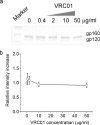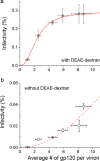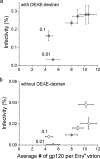Quantitative Correlation between Infectivity and Gp120 Density on HIV-1 Virions Revealed by Optical Trapping Virometry
- PMID: 27129237
- PMCID: PMC4933225
- DOI: 10.1074/jbc.M116.729210
Quantitative Correlation between Infectivity and Gp120 Density on HIV-1 Virions Revealed by Optical Trapping Virometry
Erratum in
-
Quantitative correlation between infectivity and Gp120 density on HIV-1 virions revealed by optical trapping virometry.J Biol Chem. 2017 Feb 17;292(7):3061. doi: 10.1074/jbc.A116.729210. J Biol Chem. 2017. PMID: 28213534 Free PMC article. No abstract available.
Abstract
The envelope glycoprotein (Env) gp120/gp41 is required for HIV-1 infection of host cells. Although in general it has been perceived that more Env gives rise to higher infectivity, the precise quantitative dependence of HIV-1 virion infectivity on Env density has remained unknown. Here we have developed a method to examine this dependence. This method involves 1) production of a set of single-cycle HIV-1 virions with varied density of Env on their surface, 2) site-specific labeling of Env-specific antibody Fab with a fluorophore at high efficiency, and 3) optical trapping virometry to measure the number of gp120 molecules on individual HIV-1 virions. The resulting gp120 density per virion is then correlated with the infectivity of the virions measured in cell culture. In the presence of DEAE-dextran, the polycation known to enhance HIV-1 infectivity in cell culture, virion infectivity follows gp120 density as a sigmoidal dependence and reaches an apparent plateau. This quantitative dependence can be described by a Hill equation, with a Hill coefficient of 2.4 ± 0.6. In contrast, in the absence of DEAE-dextran, virion infectivity increases monotonically with gp120 density and no saturation is observed under the experimental conditions. These results provide the first quantitative evidence that Env trimers cooperate on the virion surface to mediate productive infection by HIV-1. Moreover, as a result of the low number of Env trimers on individual virions, the number of additional Env trimers per virion that is required for the optimal infectivity will depend on the inclusion of facilitating agents during infection.
Keywords: glycoprotein; human immunodeficiency virus (HIV); infection; optical tweezers; protein cross-linking; single particle analysis; single-molecule biophysics.
© 2016 by The American Society for Biochemistry and Molecular Biology, Inc.
Figures






References
-
- Chertova E., Bess J. W. Jr., Crise B. J., Sowder I. R. II, Schaden T. M., Hilburn J. M., Hoxie J. A., Benveniste R. E., Lifson J. D., Henderson L. E., and Arthur L. O. (2002) Envelope glycoprotein incorporation, not shedding of surface envelope glycoprotein (gp120/SU), is the primary determinant of SU content of purified human immunodeficiency virus type 1 and simian immunodeficiency virus. J. Virol. 76, 5315–5325 - PMC - PubMed
-
- Zhu P., Liu J., Bess J. Jr., Chertova E., Lifson J. D., Grisé H., Ofek G. A., Taylor K. A., and Roux K. H. (2006) Distribution and three-dimensional structure of AIDS virus envelope spikes. Nature 441, 847–852 - PubMed
Publication types
MeSH terms
Substances
Grants and funding
LinkOut - more resources
Full Text Sources
Other Literature Sources
Medical

